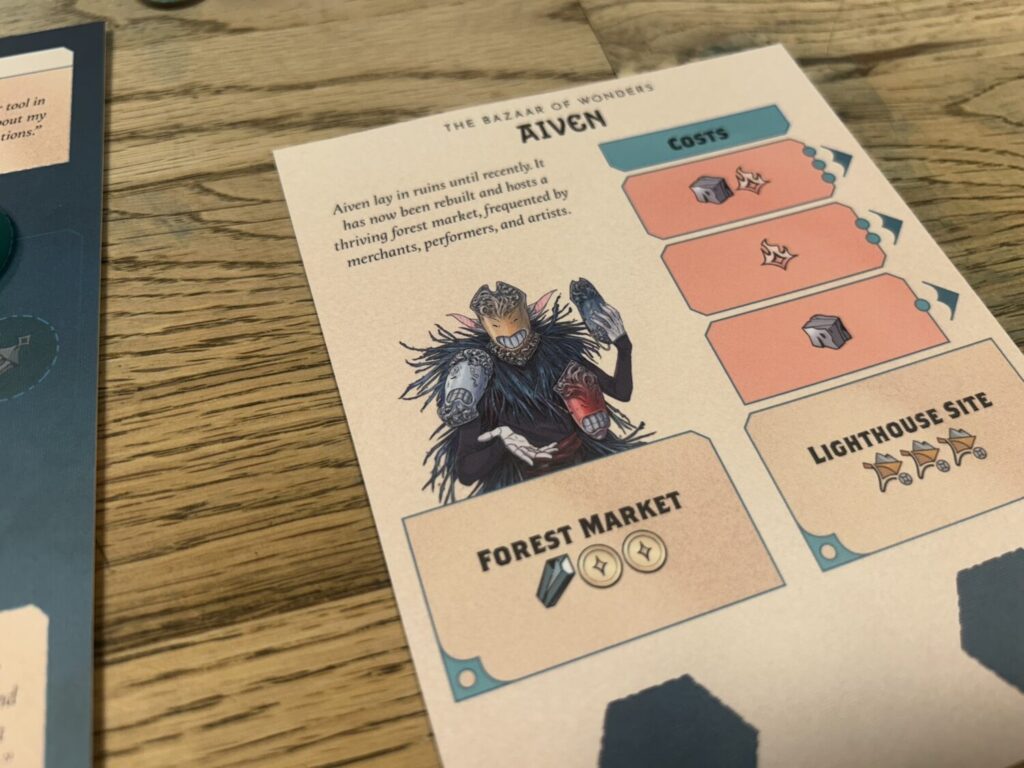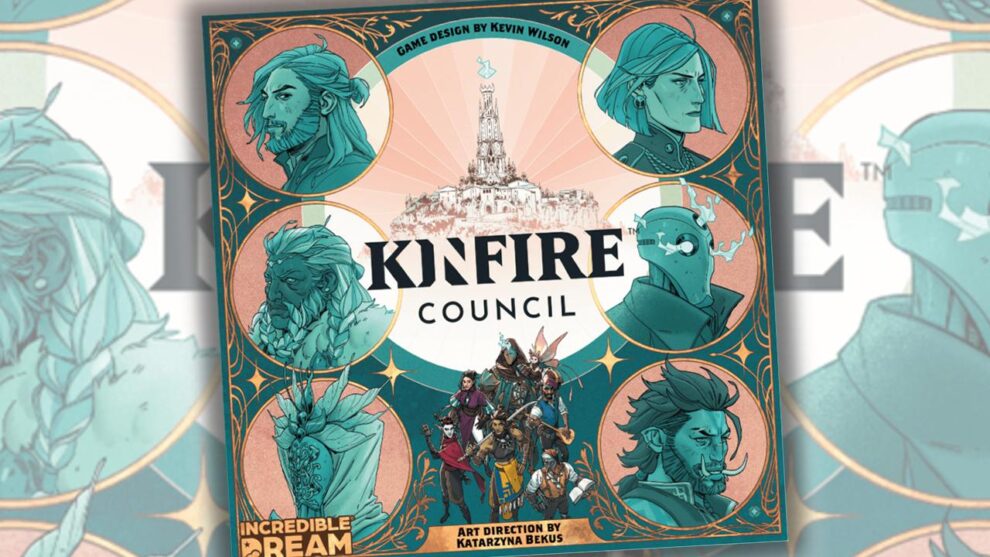Disclosure: Meeple Mountain received a free copy of this product in exchange for an honest, unbiased review. This review is not intended to be an endorsement.
I’m starting to see the bigger picture. Kinfire Chronicles, which came out in 2023, was a narrative campaign game. Last year brought Kinfire Delve, a cooperative dungeon crawler with smaller scope but no less ambition. Now we have Kinfire Council, a worker placement game with a bunch of other systems bolted onto the sides. If I didn’t know any better—and I don’t—I would say the world of Kinfire is shaping up to be another Valeria, a setting and series that will slowly grow to incorporate every mechanic under the sun.
I would not otherwise compare them. What Valeria titles I’ve played feel competent but flat. Uninspired, paint by numbers, you get the idea. The Kinfire games are a different class. Kevin Wilson, the common designer between all three titles, is really trying something here. With Chronicles and Delve, his success was total. With Council, I feel he trips a bit.

Cultists
The core of Kinfire Council is a worker placement game, and what breadth of places it offers. There are, from turn one, nineteen distinct positions, and that’s just on the main board. It is initially overwhelming. Heck, it’s overwhelming halfway through the game, and all the more so when you consider that each of those nineteen spaces has at least two different actions.
The good news is that none of those actions are complicated. Most are related to resource management along the lines of Trade an A for two Bs. That’s not true of every action space, but this is certainly not a game for the faint of heart when it comes to balancing ledgers. When you aren’t converting resources, you might send goods to aid in the construction of a lighthouse, attempt to prevent an imminent Threat, or cast votes in favor of one of the round’s two possible decrees. Within the world of Kinfire Council, there’s much to do.
And, as if you didn’t already have enough to deal with, the city of Kinfire is all the while being overrun by a cult. They take the form of tokens that cover placement spaces. What spaces, exactly, are determined by the numbers on the tokens drawn at the beginning of each round. This, to me, is fun. It’s a nice, setting-infused way of cutting off certain spaces. Cult members can be arrested by placing workers in spaces adjacent to them, and their tokens can be subsequently traded in—at certain spaces, of course—for a variety of goods. There’s a tension to removing the Cultists that I really appreciate: If I remove this now, it opens up the space for other players to use.
The Cultists are, at least theoretically, pretty central to the whole design. In addition to blocking spaces, they also wreak havoc via Threats, which have all manner of city-wide negative effects. They even have their own score marker, and if they score more points than anyone else, you all lose. While Kinfire Council is a competitive game, the Cultists ensure that everyone is to some extent in this together.
Politicking
This brings me to the first of my two major issues with Kinfire Council: it seems like it fails on its own terms. Kinfire Council doesn’t want to be a straightforward worker placement game. It promises, and aspires to, politics—an amount of politics the gameplay simply doesn’t support.
Let’s start with the Decrees, of which there are two every round. One of the actions available across the board is Voting, which allows players to place Influence tokens on the Decree of their choice. At the end of each round, the Decree with more support passes. There can be some jockeying for majority, since the Decrees typically only benefit the player(s) who voted most for them, but those benefits aren’t substantive enough to become a focus. By spending turns voting, you are choosing not to do other things, and it all seems to balance out in the wash.
To try and shake things up, the Decree deck includes Crisis cards, which trigger a negative consequence for the city if they don’t receive the majority of the votes. That’s a play at tension, to create circumstances where one player desperately wants a Decree to pass, but everyone else fears the impact of the Crisis. That isn’t what happens. It is my general experience that the Decrees are inconsequential enough, and the Crises severe enough, that nobody at the table disagrees with voting for the Crisis. One player sends a single vote to ensure that the Crisis is dealt with, and everyone places a moratorium on voting for the rest of the round.
I don’t think Kinfire Council wants things to play out that way. I get the impression from the manual and the general design that those Decrees are meant to be a serious point of focus, or at the very least that they should generate intrigue and maneuvering. They don’t do that.
The same is true of the Cult, which is meant to be much more interesting than it is. A player can align themselves with the Cult over the course of the game, they can hitch their wagon to that Cultly cause, and theoretically win if the Cult outscores everyone else, but…that seems unlikely. Scoring for the Cult is determined by incomplete Lighthouses and a few random cards drawn over the course of the game. The scoring impetus for finishing Lighthouses is too high for players to leave much unconstructed. In my four-player game, the Cult’s theoretical maximum score had already been well exceeded by two players before the end of the third of five rounds. At higher player counts, it becomes more likely that they’d be a threat.
Furthermore, there isn’t much a player can do to actively advance the Cult’s interests, which brings us to my other issue with Kinfire Council: too much space.
Space Fatigue
The number of spaces on offer is not to Kinfire Council’s benefit, for a variety of reasons.
With 19+ spaces available, and 2+ actions in most of those spaces, there are so many actions on this board that you would need to play several times to really know your options. “I go here for wood and here for sheep and here to build fences,” this is not. If the number of spaces becomes less overwhelming by the end of the game, it has more to do with you becoming numb than it does any sense of comfort. You surrender yourself to the deluge.
This is not to say that the spaces themselves are complicated. They aren’t. None of them are. Like I said before, it’s mostly variations on “Trade an A for two Bs.” In fact, after a moment, you come to realize that the options on your turn are surprisingly limited. There aren’t that many things to do in this game, really, if you consider, as I do, various forms of resource conversion to be the same action.
From there, you let your eyes skim across the surface of the board, and you quickly realize, despite the high player count—Council easily takes six—and the presence of Cultists, that there are so many spaces, with so many overlapping actions available, that you are rarely cut off from doing what you want. Your last turn each round might be restricted. Might. So long as you didn’t completely screw the pooch, you will rarely find yourself cut off from something you want to do.
There’s nothing wrong with that, but it creates a worker placement game with almost no player interaction. The options available to you are too wide, the number of relatively indistinguishable levers too various. I can’t figure out what you’re trying to do, and even if I could, we come to the classic Euro conundrum: why would I go out of my way to stop you when it’s more in my interest to do what I want to do?
A Compliment Sandwich
Kinfire Council does a lot of things very well. The iconography is clean. The production is exceptional. It may initially present as another over-the-top result of crowdfunding, but the tiered city board, the dual-layers, and the chunky worker tokens all serve specific purposes within the design. For all that the game has going on, for all the subsystems and extra bits, it runs smooth. You don’t get lost in the structure, and you don’t forget things. I also adore the worker customization system, which allows you to tailor your workers to your interests over the course of the game. The implementation of that system is clean, and I hope future games steal from it without shame.
The art is magnificent, as has been true of every Kinfire game. I think this game might include my favorite board game illustration I’ve ever seen? The work here is entirely evocative of setting and place and tone and makes me want to hear stories.
 Kinfire Council, I believe, desperately wants to tell me those stories. Everything about this design suggests a game overflowing with ambition, that wants players politicking, making tradeoffs, scheming against one another, and occasionally celebrating together. The reality is that it feels more like an unremarkable worker placement game with a few too many doodads bolted on. That’s alright with me, I’d rather a game try and miss than never try at all, but it does leave Kinfire Council in an odd position.
Kinfire Council, I believe, desperately wants to tell me those stories. Everything about this design suggests a game overflowing with ambition, that wants players politicking, making tradeoffs, scheming against one another, and occasionally celebrating together. The reality is that it feels more like an unremarkable worker placement game with a few too many doodads bolted on. That’s alright with me, I’d rather a game try and miss than never try at all, but it does leave Kinfire Council in an odd position.
If you want to negotiate with your friends, there are better games for that. If you want to play a cutthroat worker placement game, there are better games for that. If you want to play a Kinfire game, and why wouldn’t you, there are better games for that. Kinfire Council is by no means bad, but it never quite coheres into anything compelling. Its greatest strength, on a practical level, is that it’s a worker placement game that can take six players and wrap up inside of two hours. For some people, that will be enough.











